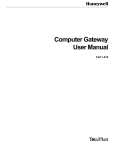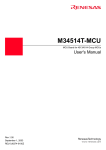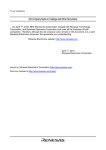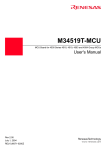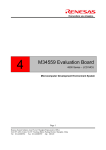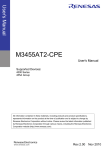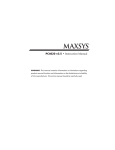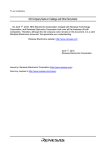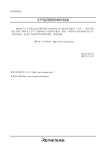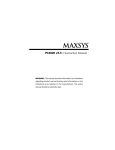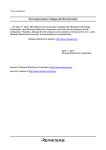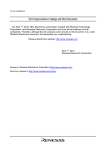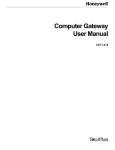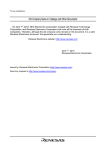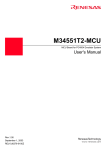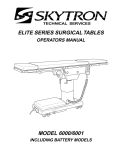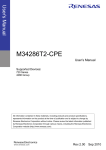Download PC4504 User`s Manual - Renesas Electronics
Transcript
To our customers, Old Company Name in Catalogs and Other Documents On April 1st, 2010, NEC Electronics Corporation merged with Renesas Technology Corporation, and Renesas Electronics Corporation took over all the business of both companies. Therefore, although the old company name remains in this document, it is a valid Renesas Electronics document. We appreciate your understanding. Renesas Electronics website: http://www.renesas.com April 1st, 2010 Renesas Electronics Corporation Issued by: Renesas Electronics Corporation (http://www.renesas.com) Send any inquiries to http://www.renesas.com/inquiry. Notice 1. 2. 3. 4. 5. 6. 7. All information included in this document is current as of the date this document is issued. Such information, however, is subject to change without any prior notice. Before purchasing or using any Renesas Electronics products listed herein, please confirm the latest product information with a Renesas Electronics sales office. Also, please pay regular and careful attention to additional and different information to be disclosed by Renesas Electronics such as that disclosed through our website. Renesas Electronics does not assume any liability for infringement of patents, copyrights, or other intellectual property rights of third parties by or arising from the use of Renesas Electronics products or technical information described in this document. No license, express, implied or otherwise, is granted hereby under any patents, copyrights or other intellectual property rights of Renesas Electronics or others. You should not alter, modify, copy, or otherwise misappropriate any Renesas Electronics product, whether in whole or in part. Descriptions of circuits, software and other related information in this document are provided only to illustrate the operation of semiconductor products and application examples. You are fully responsible for the incorporation of these circuits, software, and information in the design of your equipment. Renesas Electronics assumes no responsibility for any losses incurred by you or third parties arising from the use of these circuits, software, or information. When exporting the products or technology described in this document, you should comply with the applicable export control laws and regulations and follow the procedures required by such laws and regulations. You should not use Renesas Electronics products or the technology described in this document for any purpose relating to military applications or use by the military, including but not limited to the development of weapons of mass destruction. Renesas Electronics products and technology may not be used for or incorporated into any products or systems whose manufacture, use, or sale is prohibited under any applicable domestic or foreign laws or regulations. Renesas Electronics has used reasonable care in preparing the information included in this document, but Renesas Electronics does not warrant that such information is error free. Renesas Electronics assumes no liability whatsoever for any damages incurred by you resulting from errors in or omissions from the information included herein. Renesas Electronics products are classified according to the following three quality grades: “Standard”, “High Quality”, and “Specific”. The recommended applications for each Renesas Electronics product depends on the product’s quality grade, as indicated below. You must check the quality grade of each Renesas Electronics product before using it in a particular application. You may not use any Renesas Electronics product for any application categorized as “Specific” without the prior written consent of Renesas Electronics. Further, you may not use any Renesas Electronics product for any application for which it is not intended without the prior written consent of Renesas Electronics. Renesas Electronics shall not be in any way liable for any damages or losses incurred by you or third parties arising from the use of any Renesas Electronics product for an application categorized as “Specific” or for which the product is not intended where you have failed to obtain the prior written consent of Renesas Electronics. The quality grade of each Renesas Electronics product is “Standard” unless otherwise expressly specified in a Renesas Electronics data sheets or data books, etc. “Standard”: 8. 9. 10. 11. 12. Computers; office equipment; communications equipment; test and measurement equipment; audio and visual equipment; home electronic appliances; machine tools; personal electronic equipment; and industrial robots. “High Quality”: Transportation equipment (automobiles, trains, ships, etc.); traffic control systems; anti-disaster systems; anticrime systems; safety equipment; and medical equipment not specifically designed for life support. “Specific”: Aircraft; aerospace equipment; submersible repeaters; nuclear reactor control systems; medical equipment or systems for life support (e.g. artificial life support devices or systems), surgical implantations, or healthcare intervention (e.g. excision, etc.), and any other applications or purposes that pose a direct threat to human life. You should use the Renesas Electronics products described in this document within the range specified by Renesas Electronics, especially with respect to the maximum rating, operating supply voltage range, movement power voltage range, heat radiation characteristics, installation and other product characteristics. Renesas Electronics shall have no liability for malfunctions or damages arising out of the use of Renesas Electronics products beyond such specified ranges. Although Renesas Electronics endeavors to improve the quality and reliability of its products, semiconductor products have specific characteristics such as the occurrence of failure at a certain rate and malfunctions under certain use conditions. Further, Renesas Electronics products are not subject to radiation resistance design. Please be sure to implement safety measures to guard them against the possibility of physical injury, and injury or damage caused by fire in the event of the failure of a Renesas Electronics product, such as safety design for hardware and software including but not limited to redundancy, fire control and malfunction prevention, appropriate treatment for aging degradation or any other appropriate measures. Because the evaluation of microcomputer software alone is very difficult, please evaluate the safety of the final products or system manufactured by you. Please contact a Renesas Electronics sales office for details as to environmental matters such as the environmental compatibility of each Renesas Electronics product. Please use Renesas Electronics products in compliance with all applicable laws and regulations that regulate the inclusion or use of controlled substances, including without limitation, the EU RoHS Directive. Renesas Electronics assumes no liability for damages or losses occurring as a result of your noncompliance with applicable laws and regulations. This document may not be reproduced or duplicated, in any form, in whole or in part, without prior written consent of Renesas Electronics. Please contact a Renesas Electronics sales office if you have any questions regarding the information contained in this document or Renesas Electronics products, or if you have any other inquiries. (Note 1) “Renesas Electronics” as used in this document means Renesas Electronics Corporation and also includes its majorityowned subsidiaries. (Note 2) “Renesas Electronics product(s)” means any product developed or manufactured by or for Renesas Electronics. User’s Manual PC4504 User’s Manual Emulator System for 4500 Series Rev.1.00 2003.10 • Microsoft, MS-DOS, Windows, and Windows NT are registered trademarks of Microsoft Corporation in the U.S. and other countries. • IBM and AT are registered trademarks of International Business Machines Corporation. • All other brand and product names are trademarks, registered trademarks or service marks of their respective holders. Keep safety first in your circuit designs! • Renesas Technology Corporation and Renesas Solutions Corporation put the maximum effort into making semiconductor products better and more reliable, but there is always the possibility that trouble may occur with them. Trouble with semiconductors may lead to personal injury, fire or property damage. Remember to give due consideration to safety when making your circuit designs, with appropriate measures such as (i) placement of substitutive, auxiliary circuits, (ii) use of nonflammable material or (iii) prevention against any malfunction or mishap. Notes regarding these materials • These materials are intended as a reference to assist our customers in the selection of the Renesas Technology product best suited to the customer's application; they do not convey any license under any intellectual property rights, or any other rights, belonging to Renesas Technology Corporation, Renesas Solutions Corporation or a third party. • Renesas Technology Corporation and Renesas Solutions Corporation assume no responsibility for any damage, or infringement of any third-party's rights, originating in the use of any product data, diagrams, charts, programs, algorithms, or circuit application examples contained in these materials. • All information contained in these materials, including product data, diagrams, charts, programs and algorithms represents information on products at the time of publication of these materials, and are subject to change by Renesas Technology Corporation and Renesas Solutions Corporation without notice due to product improvements or other reasons. It is therefore recommended that customers contact Renesas Technology Corporation, Renesas Solutions Corporation or an authorized Renesas Technology product distributor for the latest product information before purchasing a product listed herein. The information described here may contain technical inaccuracies or typographical errors. Renesas Technology Corporation and Renesas Solutions Corporation assume no responsibility for any damage, liability, or other loss rising from these inaccuracies or errors. Please also pay attention to information published by Renesas Technology Corporation and Renesas Solutions Corporation by various means, including the Renesas home page (http://www.renesas.com). • When using any or all of the information contained in these materials, including product data, diagrams, charts, programs, and algorithms, please be sure to evaluate all information as a total system before making a final decision on the applicability of the information and products. Renesas Technology Corporation and Renesas Solutions Corporation assume no responsibility for any damage, liability or other loss resulting from the information contained herein. • Renesas Technology semiconductors are not designed or manufactured for use in a device or system that is used under circumstances in which human life is potentially at stake. Please contact Renesas Technology Corporation, Renesas Solutions Corporation or an authorized Renesas Technology product distributor when considering the use of a product contained herein for any specific purposes, such as apparatus or systems for transportation, vehicular, medical, aerospace, nuclear, or undersea repeater use. • The prior written approval of Renesas Technology Corporation and Renesas Solutions Corporation is necessary to reprint or reproduce in whole or in part these materials. • If these products or technologies are subject to the Japanese export control restrictions, they must be exported under a license from the Japanese government and cannot be imported into a country other than the approved destination. Any diversion or reexport contrary to the export control laws and regulations of Japan and/or the country of destination is prohibited. • Please contact Renesas Technology Corporation or Renesas Solutions Corporation for further details on these materials or the products contained therein. Precautions to be taken when using this product • This product is a development supporting unit for use in your program development and evaluation stages. In mass-producing your program you have finished developing, be sure to make a judgment on your own risk that it can be put to practical use by performing integration test, evaluation, or some experiment else. • In no event shall Renesas Solutions Corporation be liable for any consequence arising from the use of this product. • Renesas Solutions Corporation strives to renovate or provide a workaround for product malfunction at some charge or without charge. However, this does not necessarily mean that Renesas Solutions Corporation guarantees the renovation or the provision under any circumstances. • This product has been developed by assuming its use for program development and evaluation in laboratories. Therefore, it does not fall under the application of Electrical Appliance and Material Safety Law and protection against electromagnetic interference when used in Japan. • Do not attempt to modify this equipment. If modified, your authority to operate this equipment might be voided by FCC. Note: This equipment has been tested and found to comply with the limits for a Class A digital device, pursuant to part 15 of the FCC Rules. These limits are designed to provide reasonable protection against harmful interference when the equipment is operated in a commercial environment. This equipment generates, uses, and can radiate radio frequency energy and, if not installed and used in accordance with the instruction manual, may cause harmful interference to radio communications. Operation of this equipment in a residential area is likely to cause harmful interference in which case the user will be required to correct the interference at his own expense. Warning: This is a Class A product. In a domestic environment this product may cause radio interference in which case the user may be required to take adequate measures. For inquiries about the contents of this document or product, fill in the text file the installer of the emulator debugger generates in the following directory and email to your local distributor. \SUPPORT\Product-name\SUPPORT.TXT Renesas Tools Homepage http://www.renesas.com/en/tools ( 2 / 32 ) Preface The emulator PC4504 is an emulator system for the Renesas 4500 Series of 4-bit microcomputers. The PC4504 emulator system consists of the emulator PC4504, MCU board, emulator debugger M3T-PD45, and host machine. This manual describes the specifications of the emulator PC4504 and how to set up it. For information about the MCU board and emulator debugger M3T-PD45, refer to the document included with each product. All the components of this product are shown in "Table 3.1 PC4504 package contents" (page 17) of this user's manual. If there is any question or doubt about this product, contact your local distributor. To use the product properly Precautions for Safety: • In both this user's manual and on the product itself, several icons are used to insure proper handling of this product and also to prevent injuries to you or other persons, or damage to your properties. • The icons' graphic images and meanings are given in "Chapter 1. Precautions for Safety". Be sure to read this chapter before using the product. ( 3 / 32 ) Table of Contents Chapter 1 Precautions for Safety 1.1 Safety Symbols and Meanings ........................................................................................................................... 7 Warning Warnings for AC Power Supply ............................................................................................................ 8 Warnings to Be Taken for This Product ............................................................................................... 8 Warnings for Installation ....................................................................................................................... 8 Warning for Use Environment ............................................................................................................... 9 Caution Cautions to Be Taken for This Product ................................................................................................. 9 Caution for AC Power Supply ............................................................................................................... 9 Caution for Installation .......................................................................................................................... 9 Important Notes for Board ................................................................................................................................... Notes for Power Supply ...................................................................................................................... Notes for Interface ............................................................................................................................... Others ................................................................................................................................................... Note for Installation ............................................................................................................................ Notes for Difference between Actual MCU and Emulator ............................................................... Notes for Unusual Operation .............................................................................................................. 10 10 10 10 11 11 11 Chapter 2 Overview 2.1 System Overview .............................................................................................................................................. 13 2.1.1 Emulator PC4504 ....................................................................................................................... 14 2.1.2 Emulator debugger M3T-PD45 ................................................................................................. 14 2.2 Specifications ................................................................................................................................................... 15 2.3 Differences from Renesas 720 Series ............................................................................................................... 16 2.3.1 MCU Clock in Break State ........................................................................................................ 16 2.3.2 Interrupt Enable Flag after Break ............................................................................................. 16 2.3.3 Single Step Execution ................................................................................................................ 16 Chapter 3 Setting Up 3.1 Setting Up ......................................................................................................................................................... 17 3.1.1 Package Contents ....................................................................................................................... 17 3.1.2 Internal Board Arrangement ...................................................................................................... 18 3.1.3 Setting the Baud Rate ................................................................................................................ 19 3.1.4 Installing MCU-dependent Board ............................................................................................. 21 3.1.5 Connection to Host Machine ..................................................................................................... 22 3.1.6 Front Panel Description ............................................................................................................. 23 3.1.7 Startup Diagnostic ...................................................................................................................... 24 3.1.8 Self Check Function ................................................................................................................... 25 ( 4 / 32 ) Chapter 4 Maintenance & Guarantee 4.1 Maintenance ..................................................................................................................................................... 27 4.2 Guarantee .......................................................................................................................................................... 27 4.3 Repair Provisions .............................................................................................................................................. 27 4.4 How to Request for Repair ............................................................................................................................... 28 Appendix A Interface Specifications A.1 RS-232C Connector Pin Assignments ............................................................................................................. 29 A.2 Specifications of the Converter Cable and Adapter ........................................................................................ 30 ( 5 / 32 ) MEMO ( 6 / 32 ) Chapter 1 Precautions for Safety Either in the PC4701U User's Manual or on the product, several icons are used to insure proper handling of this product and also to prevent injuries to you or other persons, or damage to your properties. This chapter describes precautions which should be taken in order to use the emulator PC4701U safely and properly. Be sure to read this chapter before using this product. 1.1 Safety Symbols and Meanings WARNING If the requirements shown in the "WARNING" sentences are ignored, the equipment may cause serious personal injury or death. CAUTION If the requirements shown in the "CAUTION" sentences are ignored, the equipment may malfunction. IMPORTANT It means important information on using this product. In addition to the three above, the following are also used as appropriate. means WARNING or CAUTION. Example: CAUTION AGAINST AN ELECTRIC SHOCK means PROHIBITION Example: DISASSEMBLY PROHIBITED means A FORCIBLE ACTION Example: UNPLUG THE POWER CABLE FROM THE RECEPTACLE. The following pages describe the symbols "WARNING", "CAUTION", and "IMPORTANT". ( 7 / 32 ) WARNING Warnings for AC Power Supply: • If the attached AC power cable does not fit the receptacle, do not alter the AC power cable and do not plug it forcibly. Failure to comply may cause electric shock and/or fire. • Do not touch the plug of the AC power cable when your hands are wet. This may cause electric shock. • This product is connected signal ground with frame ground. If your developing product is transformless (not having isolation transformer of AC power), this may cause electric shock. Also, this may give an unrepairable damage to this product and your developing one. While developing, connect AC power of the product to commercial power through isolation transformer in order to avoid these dangers. • When installing this equipment, insure that a reliable ground connection is maintained. • If other equipment is connected to the same branch circuit care should be taken not to overload the circuit. Refer to nameplate for electrical ratings. • If you smell a strange odor, hear an unusual sound, or see smoke coming from this product, then disconnect power immediately by unplugging the AC power cable from the outlet. Do not use this as it is because of the danger of electric shock and/or fire. Please, contact your local distributor. Warnings to Be Taken for This Product: • Do not disassemble or modify this product. Personal injury due to electric shock may occur if this product is disassembled and modified. • Make sure nothing falls into the cooling fan on the top panel, especially liquids, metal objects, or anything combustible. Warnings for Installation: • Do not set this product in water or areas of high humidity. Make sure that the product does not get wet. Spilling water or some other liquid into the product may cause irrepairable damage. • The cooling system of this equipment causes air to flow from the lower part of the front panel to the upper part of the rear panel. Cables or other objects must be isolated no less than 10cm (4 inches) from ventilating openings of this equipment to ensure reasonable ventilating condition. ( 8 / 32 ) WARNING Warning for Use Environment: • This equipment is to be used in an environment with a maximum ambient temperature of 35°C. Care should be taken that this temperature is not exceeded. CAUTION Cautions to Be Taken for This Product: • Use caution when handling the main unit. Be careful not to apply a mechanical shock. • Do not touch the connector pins of the emulation pod and the interface connector pins directly with your hand. • Do not pull the main unit by the probe of the emulation pod or the interface cable which are connected to this product. • Do not use inch-size screws for this equipment. The screws used in this equipment are all ISO type (meter-size) screws. When exchanging screws, use same type screws as equipped before. Caution for AC Power Supply: • When installing or connecting this product with other equipment, shut down AC power or disconnect the AC power cord from the equipment to prevent personal injury or damage to the equipment. Caution for Installation: • When in use do not place the main unit on its side. ( 9 / 32 ) IMPORTANT Notes for Board: • Do not insert boards other than the 4500 Series MCU board in the emulator PC4504 slot. • Turn off the emulator PC4504 system's power when installing or removing MCU boards, setting jumper switches, or connecting/removing target cables. • Keep the board slot cover closed during normal use. Notes for Power Supply: • The emulator PC4504 system's power supply switches automatically between 100V and 200V. However, be sure to use the AC cable that matches the used voltage. Do not modify the attached cable because it can cause accidental fire or electrocution. • Do not attempt to remove, disassemble, or repair the emulator PC4504 power supply. Otherwise the correct performance cannot be guaranteed. Notes on Interface: • The RS-232C serial interface cable is used to communicate with the host machine. However, it may not be possible to communicate with some host machines even if the interface is normal. • Some host machines may require change in the connection of the attached RS-232C serial interface cable due to the difference in the arrangement of pins TxD and RxD. • Be sure to turn off the emulator PC4504 when connecting or removing the interface cable. Others: • Do not attempt to disassemble the emulator PC4504 system. If you must disassemble (to remove foreign objects for example), be sure to turn off the power switch and disconnect the AC cable. • Do not place coffee cups, bottles, or other liquid containers on top of the emulator PC4504. Accidental spillage may damage the system beyond repair. • Do not block the ventilation ports at the bottom and side of the emulator PC4504. Blocking the ventilation ports can damage the emulator PC4504 system. • Take extra precaution when moving the emulator PC4504 system. Especially avoid shock when placing the system. ( 10 / 32 ) IMPORTANT Note for Installation: • The emulator PC4504 does not operate standalone. It must always be connected with the emulation pod before you can execute self-check after setting up. Notes for Difference between Actual MCU and Emulator: • Emulator operation differs from a mask MCU, as listed below: (1) Reset condition (2) Initial values of internal resource data at power-on (3) Internal RAM and ROM capacities (4) A-D converter characteristics For details refer to each user's manual of MCU boards. • Therefore, always be sure to evaluate your system with an evaluation MCU (OTP or EPROM version). Also, be sure to perform board-mounted evaluation with ES (Engineering Sample) version MCU to make final confirmation of device operation before starting mask production. Notes for Unusual Operation: • Do not turn off the power when executing self-check or downloading firmware. If the emulator PC4504 is powered off in the middle of a process, it will become unable to start up normally. In cases when the power is inadvertently shut off, re-execute self-check or downloading. • If self-check does not terminate normally, the emulator PC4504 can be faulty. In such a case, contact your local distributor. • If the emulator malfunctions due to external interference or some other causes, follow the steps given below. (1) Press the system reset switch on the front panel of the emulator PC4504. (2) If the emulator doesn't return to the normal operation despite the step (1) above, turn off the power source of the emulator PC4504, and turn it on again. ( 11 / 32 ) MEMO ( 12 / 32 ) Chapter Overview 2 2.1 System Overview The PC4504 is an emulator for the Renesas 4500 Series of 4-bit microcomputers. The emulator PC4504 is used with an MCU board for each MCU of the 4500 Series (PC4504 emulator system). The emulator PC4504 is controlled by the emulator debugger M3T-PD45 running on a personal computer through an RS-232C serial interface. Serial interface External trace cable Host machine PC4504 (MCU board [option] installed) Figure 2.1 PC4504 system configuration ( 13 / 32 ) Target system Table 2.1 lists the PC4504 system product organization. Table 2.1 PC4504 system product organization Description Product Hardware PC4504 M345xxT-MCU Software PD45 Emulator (includes system cabinet with power supply, emulator control board, real-time trace board, and others) MCU board (option) Emulator debugger (includes assembler ASM45 and cross referencer CRF45) 2.1.1 Emulator PC4504 The PC4504 is a common emulator hardware for the 4500 Series. It enables system hardware/ software development and debugging by installing a separately sold MCU board appropriate for each MCU. 2.1.2 Emulator debugger M3T-PD45 Emulator debugger M3T-PD45 controls emulator PC4504 from a personal computer and performs the following: • Load and execute object file (HEX file) generated from assembler ASM45. • Display MCU internal registers and memory contents to check the operation of the program. • Stop program execution under predefined condition (referred to as breakpoints) and restart the program after check it. • Log and display addresses output by an MCU, executed codes, and external signal status (realtime trace function). ( 14 / 32 ) 2.2 Specifications Table 2.2 PC4504 specifications Applicable MCU Internal emulation memory Real-time trace memory Break function Trace function Time measurement C0 coverage Interface Baud rate Supply voltage Weight 4500 Series 10 bits x 16K word 4096 cycles [Break point] Hardware break • 2 address points (pass count/range can be set) • 1 external trigger point [Break mode] 1. Address break or trigger break 2. Stack over/under flow 3. Trace event 4. Break at end of trace 5. Timer [Trace point] Real-time trace • 2 address points (pass count/range can be set) • 1 external trigger point [Trace mode] 1. BEFORE mode (records 4096 cycles before end conditions are met) 2. ABOUT mode (records 4096 cycles before and after when conditions are met) 3. AFTER mode (records 4096 cycles after end conditions are met) [Trace space] 1. Break point synchronizing • Before break point (BEFORE) 2. Trace point synchronizing • Before trace point (BEFORE) • Before and after trace point (ABOUT) • After trace point (AFTER) [Time measurement points] 2 address points (range can be set) [Resolution] 250ns [Count source] Emulator timer and MCU cycle Available Serial (RS-232C) 9,600 bps or 19,200 bps Can be selected by the jumper switch of the PCA4500E board on the emulator PC4504 main unit (see Page 19) AC 85 to 264V (50/60Hz) 5.7kg (not including MCU board) ( 15 / 32 ) 2.3 Differences from Renesas 720 Series In addition to the enhanced debugging functions, the PC4504 emulator system differs from the PC4400 emulator system for Renesas 720 Series in the following way. 2.3.1 MCU Clock in Break State The emulator PC4504 allows the clock to the MCU during break to be supplied/stopped with emulator debugger M3T-PD45 commands. Debugging is made easier by allowing the clock to be controlled according to the MCU function to be debugged. Supply: The LCD is lit and PWM output is available during break so that these functions can be debugged. Stop: During break the timer stops because the clock is stopped*. This is useful for timer related debugging. * When register and internal RAM reference/modify command is executed. The emulator PC4504 supplies the clock to the MCU to process. 2.3.2 Interrupt Enable Flag after Break The emulator PC4504 saves the MCU internal interrupt enable flag before and after a break. 2.3.3 Single Step Execution The single step execution related restrictions have been removed from the emulator PC4504. 1. Whether the instruction following the skip instruction has been skipped or not is correctly displayed. 2. The RT, RTS, and TABP instructions following a skip instruction can be debugged properly. ( 16 / 32 ) Chapter Setting Up 3 3.1 Setting Up 3.1.1 Package Contents Table 3.1 lists the emulator PC4504 package component. Table 3.1 PC4504 package contents Item PC4504 emulator main unit External trace cable Serial cable Power cable 25-pin female to 25-pin female conversion cable 9-pin female to 25-pin female conversion adapter User's Manual Quantity 1 1 1 1 1 1 1 Note: * The original box and packing materials should be stored in a safe place. They should be used when transporting the emulator PC4504 in case of repair for instance. When transporting, remove all installed devices that are not standard and transport as precision instrument. If the original box and packing material are unavailable, pack carefully and handle as precision instrument. * We appreciate any comments regarding the packaging of this product. ( 17 / 32 ) 3.1.2 Internal Board Arrangement After unpacking the emulator PC4504 system, a shock absorbing material must be removed from under the top cover. Refer to Figure 3.1 to remove this material. Remove 2 screws Remove 2 screws and remove the slot cover Shock absorber Figure 3.1 Removing the packing foam There are four slots for inserting circuit boards (see Figure 3.2) inside the emulator PC4504. The following boards are inserted in each slot at delivery. • PCA4500E (Monitor CPU board) ........................................................................................... slot 1 • PCA4504A (Control board) ..................................................................................................... slot 2 • PCA4504R (Real-time trace board) ........................................................................................ slot 3 Power switch side 1 : Slot 1 2 : Slot 2 3 : Slot 3 4 : Slot 4 Front panel side Figure 3.2 PC4504 slots ( 18 / 32 ) 3.1.3 Setting the Baud Rate The emulator debugger M3T-PD45 supports two types of a communication baud rate (9,600 bps and 19,200 bps, default: 9,600 bps) to communicate with emulator PC4504. How to set the communication baud rate is shown below. (1) Removing the slot cover When changing the setting of the communication baud rate, shut off the power switch of the emulator PC4504. Then, remove the board slot cover as shown in Figure 3.1. (2) Removing internal boards Exerting a slight outward pressure to the bilateral plastic cards of each board, remove the following boards installed in the slots of the emulator PC4504 main unit from near side. 1. MCU-dependent board (M345xxT-MCU) 2. Real-time trace board (PCA4504R) 3. Control board (PCA4504A) Now, only the monitor CPU board (PCA4500E) is installed in the emulator PC4504 main unit. The monitor CPU board (PCA4500E) is fixed to the emulator PC4504 main unit. Monitor CPU board PCA4500E (3) Control board PC4504A (2) Real-time trace board PCA4504R (1) MCU-dependent board M345xxT-MCU Connector RS-232C Power switch side Figure 3.3 Removing the internal boards ( 19 / 32 ) (3) Setting the communication baud rate There is the jumper switch JP1 for changing the baud rate at the center of the monitor CPU board (PCA4500E). Change the setting of the jumper switch according to the communication baud rate. The baud rate of the emulator PC4504 is set to 9,600 bps when it is shipped from the factory. Monitor CPU board PCA4500E 9,600 bps (Default) 19,200 bps Figure 3.4 Setting communication baud rate (4) Inserting the internal board After setting the communication baud rate, insert each board into the slots of the emulator PC4504 in the inverse order of item (2). When inserting the boards, be sure to check the order to insert and each side of boards. (5) Checking the operation After setting the communication baud rate, it is necessary to check that each board is properly installed. Turn the power of the emulator PC4504 on with all boards are installed. The emulator PC4504 checks if each system has been properly set. If the ERROR LED of the front panel is lit, each board of the emulator PC4504 may not have been properly installed. Check the operation again after checking that each board is properly set. ( 20 / 32 ) 3.1.4 Installing MCU-dependent Board Remove the slot cover of the emulator PC4504 and install the separately purchased MCU-dependent board into slot 4 (see Figure 3.2) as shown in Figure 3.5. Insert this board into Slot 4. Figure 3.5 Installing an MCU-dependent board ( 21 / 32 ) M345xxT-MCU (Front side) 3.1.5 Connection to Host Machine When using the emulator PC4504 through an RS-232C interface, use the serial cable included with the emulator PC4504 system to connect the host machine with the emulator PC4504. When using an IBM PC/AT as host, the separate conversion connector must be connected according to the type of your PC. Figure 3.6 shows the connection for IBM PC and Figure 3.7 shows the connection for IBM PC/AT. 25-pin female to 25-pin female converter cable RS-232C Serial cable IBM PC side PC4504 side Figure 3.6 Connection to IBM PC using RS-232C Converter adapter IBM PC/AT side RS-232C Serial cable PC4504 side Figure 3.7 Connection to IBM PC/AT using RS-232C ( 22 / 32 ) 3.1.6 Front Panel Description The emulator PC4504 front panel contains the indicators showing the emulator PC4504 and target systems' status and reset switches. Figure 3.8 shows the emulator PC4504 front panel. Figure 3.8 Front panel Table 3.2 lists the meaning of each LED. Table 3.2 PC4504 LEDs LED STATUS OF TARGET STATUS OF SYSTEM Description POWER CLOCK RESET RUN POF POWER SAFE ERROR Turns on when power is supplied to the target system. Turns on when the clock on the MCU board is oscillating. Turns on when RESET signal is input from the target system. Turns on when a program is executed on the target MCU. Turns on when the target MCU is in power down state. Turns on when the emulator PC4504 is turned on. Turns on when the system has started up normally. Turns on when there is an error in the system. ( 23 / 32 ) Color Orange Green Red Green Red Orange Green Red 3.1.7 Startup Diagnostic When the power is turned on, the emulator PC4504 performs a self diagnostic to check whether each board is installed properly. Figure 3.9 shows how the LEDs change from the time the power is turned on until a command prompt appears. Abnormal termination (1) Abnormal termination (2) : ON : Blink : OFF Normal termination Figure 3.9 Power on sequence In Figure 3.9 above, the POWER of TARGET STATUS (*1) turns on when power is supplied to the target system regardless of whether it is supplied from the emulator PC4504 or externally. Take the following actions if the system terminates abnormally ((1) or (2) in Figure 3.9). (1) There is an error in the MCU board. Check the MCU board is installed properly. (2) There is an error in boards other than the MCU board. Check each board is installed properly. In either case, if the system continues to terminate abnormally after checking the board and repeating the power on sequence, contact your local distributor. ( 24 / 32 ) 3.1.8 Self Check Function The emulator PC4504 provides a function to check the status of the internal board memories. To use this function, do as follows: Turn on the power while holding down the reset switch on the front panel. Figure 3.10 shows how the LEDs change from the time the power is turned on until a command prompt appears. Normal termination : ON : Blink : OFF Figure 3.10 Self check function Contact your local distributor if the error cannot be corrected after repeating the power on sequence. ( 25 / 32 ) MEMO ( 26 / 32 ) Chapter Maintenance & Guarantee 4 4.1 Maintenance If dust or dirt collects on any equipment of your emulation system, wipe it off with a dry soft cloth. Do not use thinner or other solvents because these chemicals can cause the equipment's surface coating to separate. 4.2 Guarantee If your product becomes faulty within twelve months after its purchase while being used under good conditions by observing "Precautions for Safety" described in Chapter 1 of this user's manual, we will repair or replace your faulty product free of charge. Note, however, that if your product's fault is raised by any one of the following causes, we will repair it or replace it with new one with extra-charge: • • • • Misuse, abuse, or use under extraordinary conditions Unauthorized repair, remodeling, maintenance, and so on Inadequate user's system or misuse of it Fires, earthquakes, and other unexpected disasters In the above cases, contact your local distributor. If your product is being leased, consult the leasing company or the owner. 4.3 Repair Provisions (1) Repair with extra-charge The products elapsed more than one year after purchase can be repaired with extra-charge. (2) Replacement with extra-charge If your product's fault falls in any of the following categories, the fault will be corrected by replacing the entire product instead of repair, or you will be advised to purchase new one, depending on the severity of the fault. • Faulty or broken mechanical portions • Flaw, separation, or rust in coated or plated portions • Flaw or cracks in plastic portions • Faults or breakage caused by improper use or unauthorized repair or modification • Heavily damaged electric circuits due to overvoltage, overcurrent or shorting of power supply • Cracks in the printed circuit board or burnt-down patterns • Wide range of faults that makes replacement less expensive than repair • Unlocatable or unidentified faults (3) Expiration of the repair period When a period of one year elapses after the model was dropped from production, repairing products of the model may become impossible. (4) Transportation fees at sending your product for repair Please send your product to us for repair at your expense. ( 27 / 32 ) 4.4 How to Make Request for Repair If your product is found faulty, follow the procedure below to send your product for repair. Customer Fill in the Repair Request Sheet included with this product, then send it along with this product for repair to your local distributor. Make sure that information in the Repair Request Sheet is written in as much detail as possible to facilitate repair. Distributor After checking the contents of fault, the distributor should please send the faulty product along with the Repair Request Sheet to Renesas Solutions Corp. Renesas Solutions When the faulty product is repaired, it will be returned to the customer at the earliest convenience. ( 28 / 32 ) Appendix Interface Specifications A A.1 RS-232C Connector Pin Assignments Table A.1 lists the pin assignments of the serial I/O connectors CH1 and CH2. Table A.1 RS-232C connector pin arrangement Pin No. 1 2 3 4 5 6 7 8 9 10 11 12 13 14 15 16 17 18 19 20 21 22 23 24 25 Signal Frame GND RxD TxD CTS RTS DTR Signal GND NC NC NC NC NC NC NC NC NC NC NC NC DSR NC NC NC NC NC Connector shape ( 29 / 32 ) A.2 Specifications of the Converter Cable and Adapter Use the included conversion cable when connecting to host machines with male shape serial I/O connectors (D-SUB connector) such as an IBM PC/AT. Figures A.1 and A.2 show how to connect the conversion cable and conversion adapter. Check the user's manual of the host machine for the detail pin connections. 25-pin side pin No. 25-pin side pin No. Figure A.1 25-pin female to 25-pin female converter cable 25-pin side pin No. 9-pin side pin No. Figure A.2 9-pin female to 25-pin female converter adapter ( 30 / 32 ) PC4504 User's Manual Rev.1.00 October 1, 2003 REJ10J0229-0100Z COPYRIGHT ©2003 RENESAS TECHNOLOGY CORPORATION AND RENESAS SOLUTIONS CORPORATION ALL RIGHTS RESERVED PC4504 User’s Manual 1753, Shimonumabe, Nakahara-ku, Kawasaki-shi, Kanagawa 211-8668 Japan REJ10J0229-0100Z


































